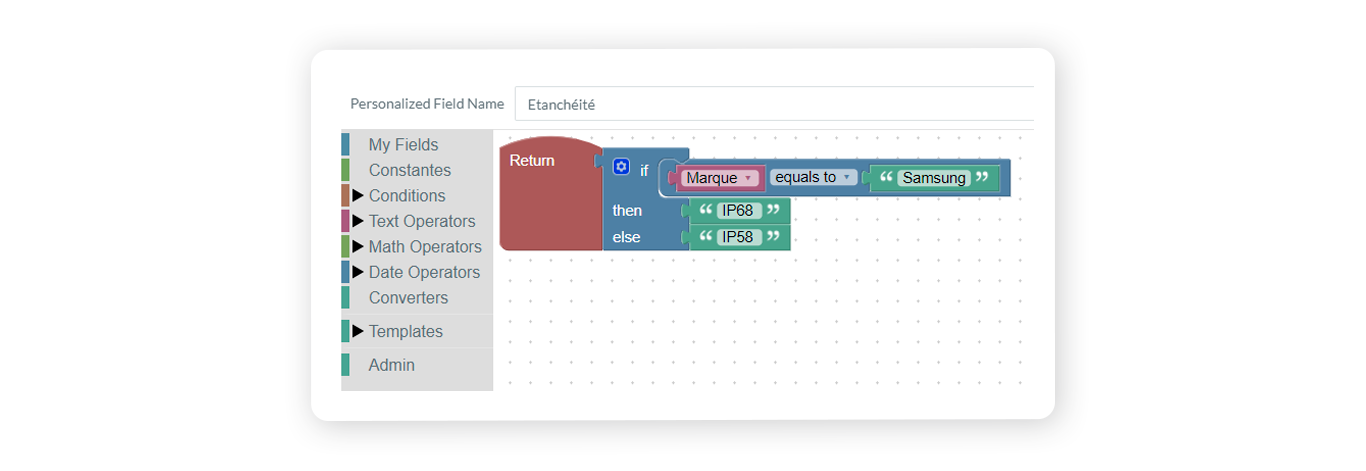Marketplaces do not all require the same matrices to integrate your products. Each has its own specifics you have to adapt to.
So: you need to structure your catalog to sell what you want on online sales platforms, but also complete your product information sheets to get maximum visibility!
The many adaptation and enrichment features of an e-commerce flow management platform like BeezUP are a real asset when it comes to standing out and performing on digital sales channels. Follow us, we will tell you how to undertake this vital structuring and personalisation of your content trouble-free.
SUMMARY
1. Filtering the categories you sell on each marketplace
Once again we come back to these tiresome matrices that you have to adapt to each marketplace and update whenever your offers change, even daily…
With BeezUP, you can choose the categories you want to sell on each marketplace and thus keep a tight rein on the products you want to publish. You no longer have to put all your eggs in the same basket or rather all your product categories on the same platform 😏
For example, you have the following three categories in your catalog: “Cabinets”, “Bedroom cabinets” and and “Baby’s cabinets”. But you only want to sell the “Cabinets” category on the BUT marketplace; as for the two others, they will be sent to Cdiscount.
At BeezUP, there’s no need to touch your source catalog. Simply map the corresponding category or categories on the marketplaces chosen. Only the mapped categories are integrated on the platform.

Here you have only mapped the “Cabinet” category, so this is the only one you will broadcast to BUT 😊
2. Select the products you are selling
Selecting the categories to broadcast on each platform is a good start, but it’s not enough. You know that putting all your eggs in the same basket isn’t a good strategy on marketplaces. So you need to be more granular and only post certain products per category. It would be a shame to undermine your business strategy or cannibalise your own online store. Don’t worry, you can also filter at product level and by marketplace. That may seem complicated, but don’t go away, we’ll explain.
Let’s take an example: you are selling chocolates, including Kinder Surprises on Amazon, unfortunately the latter have not been authorised for sale in the USA since 1938 😂. So, you want to remove them from your “Chocolate” category on Amazon USA.
📌 You have two solutions available:
1. Simply add a filter on the column you want and choose to exclude products whose title contains “Kinder Surprise”.

2. From the categories page of the Amazon USA marketplace, access the list of products, and, individually deactivate the products of your choice, such as Kinder Surprises for example.
Note that individually deactivated products can be found via our “Product Vision” and “Analytics” pages.
3. Enriching and adapting your product information with personalised fields
Now that you have selected the categories and products that you want to sell on each marketplace, you need to enrich the information on your products so that their features and attributes are as rich as possible and adapted to the specifics of each platform.
With BeezUP’s personalised fields, you can adapt to marketplace requirements. With this functionality, we have integrated Miraki marketplaces applying very different fields and features from those of PrestaShop. Without the personalised fields, we could never correctly integrate all marketplaces. Some features would always be missing. This option really enables us to work miracles!”
Florent Ducauroix, co-founder and development manager of Les Poulettes.fr
To be better referenced on marketplaces and move up in your future customers’ searches, you must include all the information they ask for. The more detailed your information sheets are, the more you will gain in visibility and increase your sale opportunities.
To do this, you have two options: enrich your data or adapt them. We will present these quickly with two examples:
👉 In the case of enrichment, let’s say you sell toys on the FNAC marketplace, you need to remove the power in Watts from the description of your products to enter it in a specific field.
👉 Now, let’s suppose you are selling clothes on Amazon France, your trousers have US sizes and you need to convert them to French sizes. You need to create a rule to say that a 33” corresponds to a size 42. That’s adaptation!
So that enrichment and adaptation no longer guard any secrets from you we are going to present them through several standard use cases, such as:
a. Enriching an incomplete flow
Your product catalog doesn’t contain any shipping costs, but all marketplaces require them. No need to add it in your source flow, you can create a rule to configure fixed shipping costs under €90 and make them free beyond this figure. 
Another example, you want to indicate the IP68 sealing standard for all your Samsung brand phones and IP58 for the others. Here again, the personalised fields enable you to enrich your flow.

Proof that you can send your content adapted, enriched and automated on marketplaces. This enables you to be more precise, gain time and avoid manual inputting errors. Configuring your fields may require a time investment at the start but once you’ve done it, it’s effective!
b. Adapting a field to a marketplace’s requirements
Let’s suppose that in the “Edible” column of your source catalog, “1” means your articles are in edible, “0” not. Only the marketplace wants to receive the “Edible” value instead of the “1”. Instead of adding a field, you can just adapt the values you already have. I.e. “1” = “Edible”. 
👉 Meet marketplaces’ requirements by automating your sales processes
c. Combining several fields
Product information sheets whose titles are explicit tend to generate more clicks. Unsurprisingly, these are those that immediately specify the essential information of the item for sale by highlighting the brand, the reference, the type of product and the colour, for example.
 The aim is to set yourself apart from among the many other similar references present on marketplaces, but also to move up in search results.
The aim is to set yourself apart from among the many other similar references present on marketplaces, but also to move up in search results.

d. Conditioning values
The Sales will soon be here and you want to change your prices, but only on this period and without touching your flows. Once again, it is our secret weapon that can help you apply a percentage reduction on your entire catalog. 
Let’s take another specific case. You are selling abroad but not all European countries have the same VAT rate: France’s is 20% while Spain’s is 21%. Here again, you can easily adapt your price to the country of the target marketplace by establishing a personalised calculation rule. 
This is done in the same way as changing currency: going from Euros to Pounds, for example.
Going through a flow management tool, you can automate the publishing of your catalog, while creating rules, filters and fields adapted to your strategic and commercial objectives and to the specifics of each marketplace.
Apart from the time gain, the use of personalised fields enables you to be relevant and gain in visibility while broadcasting enriched and adapted product information sheets, without ever affecting or changing the catalog of your own online store.
You can now publish your products and your offers on marketplaces with more or less granularity. Thanks to automation, you can sell the products you have chosen on the platforms you have selected and propose offers to your clients at the best times.
Manual structuring, integration and daily management of your product catalog is not really viable and is unlikely to last if you want to develop on several sales channels, or internationally.
As you will have understood, automation is the key to success!

Elodie TOROSSIAN
Developer Analyst at BeezUP





